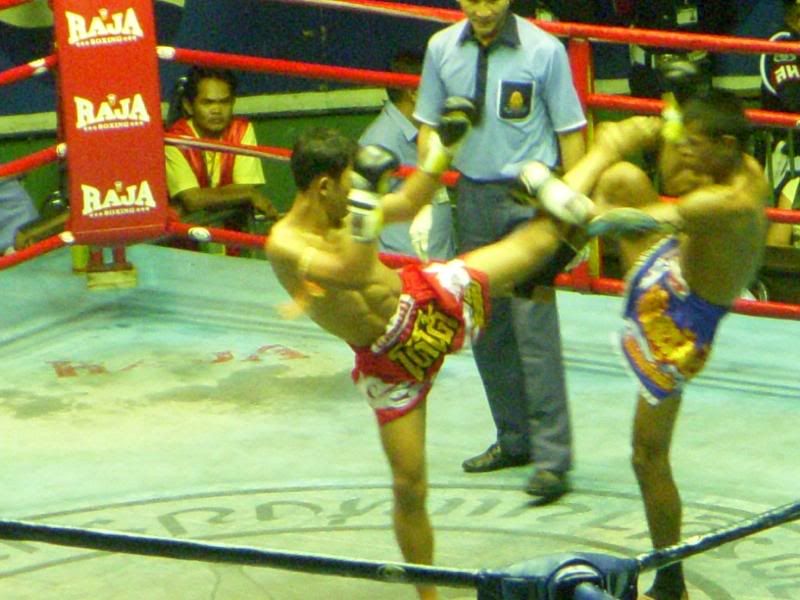
Knockout! A left kick to the jaw sends one man to the canvas. The audience drew silent as the young man in blue stood in momentary awe over his downed opponent. I couldn’t help but wonder if the crowd surrounding me was disappointed at such a quick finish: no five rounds of action, no money to change hands following a gambling frenzy. On this night, during the third official bout at Bangkok’s oldest boxing arena, one young fighter finished his job in under a minute’s time. The fighter or nak muay, seemed almost as stunned as his now sleeping adversary, and stood there absorbing what even he appeared not to expect.
Such are the risks and rewards of Thailand’s national sport, muaythai. Considered by experts to be one of the most effective fighting arts on the planet, Thai boxing has been entertaining fans in Thailand and abroad for decades.
On a recent visit to Bangkok I was sure to spend a Tuesday evening enjoying the pugilist proceedings. This night’s card consisted of ten bouts, including two preliminary events and a demonstration of muay Thai as it was executed during the nation’s Ayutthaya kingdom era.
There are as many as 60,000 nak muay in Thailand with Lumpini Stadium as one of the top competitive venues. For fight fans, Tuesday night is the height of action. It is said that here, and at Ratchadamnoen Stadium on Thursday nights, the country’s finest fighters come to test their mettle against a worthy opponent.
Originating during the pre-fire-power centuries when the Thai and Burmese kingdoms fought murderous territorial wars, muaythai has taken the action of the battlefield into the sportsmanship of the ring. Much of the brutality has not been lost, though rather than wielding long-handled swords or hemp wrapped fists dipped in broken glass, nak muay now brandish boxing gloves and blade-like shins.
It is the Burmese who originally recorded stories of this unique fighting form. In 1411 the first writings of the Thai combative style described its ferocity. Throughout the centuries, there have been changes and modifications to this art now transformed to sport. Due to its sometimes ferocious nature, death and severe injury occasionally occurred, leading the Thai government to ban competitions in the 1920’s. Following safety standards and regulations based on international boxing rules, muaythai in its contemporary form, was reintroduced to Thailand.
This night’s action began with two preliminary bouts and just a few spectators in attendance. As one of the nation’s top venues, the best fighters and their coaches come to Bangkok from outlying provinces for a single night’s competition. Often, they bring along an underling who, while talented, is not yet ready for the big league. It is these boys who entertain the first series of fans as the stadium gradually fills.
And the stadium did fill, slowly and steadily as the night progressed. By the end of the second preliminary bout the betting section, along the top tier of the arena, was crowded. By the end of the third fight, it was packed.
Fighters begin their training early in life and most are retired well before they reach the age of 30. This night’s bouts included boys mostly in their late teens and early twenties, ranging in weight from 100 to 115 pounds. They are young, well-trained, fast and powerful.
Much like western boxing, each event begins with the boxer’s entry into the ring and introduction to the audience. There is a red and blue corner, a referee and three judges who score each round. The boxers wear shorts and gloves and only occasionally behave with the bravado of an American champ. From here, however, the picture of muaythai changes dramatically.
